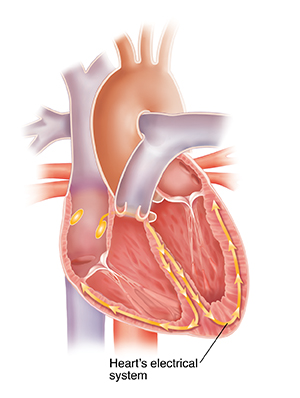Sudden Cardiac Arrest
When the heart suddenly stops beating, it's called sudden cardiac arrest. When the heart isn’t beating, it can’t pump blood. Without blood, vital organs such as the brain and the lungs can't work right. Sudden cardiac arrest causes a person to become unconscious. Breathing stops. Emergency treatment is needed to get the heart beating again. If treatment is not started right away, sudden cardiac arrest can lead to sudden cardiac death.
What causes sudden cardiac arrest?

Sudden cardiac arrest occurs because there is a problem with the electrical system of the heart. Most often, this is because of heart disease that leads to an irregular heartbeat (arrhythmia). A severe arrhythmia can cause the heart to stop beating. Most often, this is because of heart disease that leads to an irregular heartbeat (arrhythmia). Things that can lead to arrhythmia and sudden cardiac arrest include:
-
A blocked artery to the heart muscle (heart disease) that leads to a heart attack
-
Weakening of the heart muscle (heart failure)
-
Scarring or thickening of the heart muscle
-
Problems with the levels of certain minerals in the blood
-
Use of stimulant street drugs such as cocaine and methamphetamine
-
Severe injury to the chest
-
Disorders of the electrical system of the heart such as long Q-T syndrome
-
Long periods of time without oxygen, such as with a blocked airway from choking or a blood clot in the lung (pulmonary embolism)
Sudden cardiac arrest, heart disease, and heart attack
Cardiac arrest is not the same as a heart attack. Sudden cardiac arrest is a problem with the heart's electrical system. Heart attack is a problem with the heart's blood flow (circulation). But a heart attack can be a cause of sudden cardiac arrest. A heart attack is a problem with the blood flow to the heart muscle. This problem is a result of a condition called heart disease. Normally, arteries carry blood and oxygen to the heart muscle. With heart disease, one or more of the arteries get narrowed or blocked. If an artery becomes fully blocked, the heart muscle doesn’t get the oxygen it needs. This part of the heart muscle is severely injured or dies. The result is a heart attack. Death of the heart muscle may also trigger sudden cardiac arrest.
Many of the same factors that increase your risk for heart attack increase the risk for sudden cardiac arrest. These include:
-
Family history of heart disease
-
Smoking
-
Unhealthy cholesterol levels
-
High blood pressure
-
Diabetes
-
Lack of physical activity
-
Obesity
Symptoms
This condition most often happens suddenly, without warning. In some cases, you may have symptoms for a few weeks leading up to the event. These may include lightheadedness, shortness of breath, or feeling like your heart is fluttering (palpitations). But these symptoms are often general. You may ignore them or think they are caused by something else.
Symptoms during a cardiac arrest include:
Treatment
Sudden cardiac arrest is a medical emergency. Fast action is needed to reverse this life-threatening condition. Cardiopulmonary resuscitation (CPR) is the key treatment. Here’s what to do:
Always make sure the scene is safe.
-
Tap or gently shake if you see or find a person who has collapsed. In a loud voice ask "Are you OK?
-
If the person doesn't respond, shout for help and call 911 right away. Put your phone on speaker mode.
-
If you know an AED (automated external defibrillator) is available right away, get it quickly. An AED checks the heart rhythm and if needed briefly shocks the heart.
-
If other people are with you, have one of them call 911 and get an AED, if available. Use the AED as soon as you have one.
-
Check for normal breathing and a pulse. If the person is not responding and is not breathing normally, or is gasping only, or has no pulse then start CPR.
If you are not trained in CPR, the only person doing CPR, or don't want to do breaths, do chest compressions only CPR (for teens or adults).
Give chest compressions
-
Lay the person on their back on a firm, flat surface
-
Clothing can be moved out of the way.
-
Give chest compressions.
-
Place the heel of one hand on the lower half of the breastbone. Place your other hand on top of the first hand.
-
Push hard, push fast. Push at a rate of 100 to 120 chest compressions per minute. Press straight down on the chest at least 2 inches. American Heart Association recommends doing compressions to the beat of the Bee Gee's song "Stayin Alive."
-
Allow the person's chest to come back up after each compression. This allows the heart to refill with blood.
-
Keep giving chest compressions until:
-
The person shows signs of moving or breathing
-
Someone else arrives who can do CPR
-
You become exhausted and aren't able to continue
-
The scene becomes unsafe
-
Emergency medical services arrives
Where can I get CPR training?
Take a CPR class. You can take a CPR training class online or in your area. To find a class, contact American Heart Association or 800-AHA-USA-1 (800-242-8721).